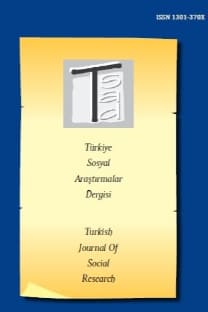İLKÖĞRETİM TÜRKÇE DERS KİTAPLARINDA BİR KÜLTÜR AKTARIMI ARACI OLARAK KALIP SÖZLERİN KULLANIMI ÜZERİNE BİR İNCELEME
Bir dilin söz varlığının öğretimi aynı zamanda o dili konuşan toplu-mun kültürünün de öğretimidir. Temel söz varlığını oluşturan ögeler içeri-sinde, insanların belli bir kültürün ürünü olarak kullandıkları kalıp sözler de yer alır. Kalıp sözler, tıpkı atasözleri ve deyimler gibi bir dili konuşan toplumun kültürüne ışık tutmakta, onun inançlarını, insan ilişkilerindeki ayrıntıları, gelenek ve göreneklerini yansıtmaktadır. Bu çalışmanın amacı İlköğretim Türkçe ders kitaplarında (1-5; 6-8) ve öğrenci çalışma kitapla-rında bir söz varlığı ögesi olarak yer alan kalıp sözlerin belirlenmesidir. Nitel araştırma yöntemine dayalı bu çalışmanın verileri doküman incele-mesi yoluyla toplanmıştır. Elde edilen veriler içerik analiziyle çözümlen-miştir...
Anahtar Kelimeler:
Dil, kültür, söz varlığı, kalıp sözler, Türkçe ders kitapları.
AN ANALYSIS OF THE PATTERNS USED AS A MEANS OF CULTURE TRANSITION IN PRIMARY EDUCATION TURKISH COURSEBOOKS
Teaching the vocabulary of a language means teaching the culture of the society that speaks the language at the same time. The patterns people use as products of a particular culture have their parts among the elements which constitute the fundamental vocabulary of a language. Patterns, just like proverbs and idioms, shed light on a society’s culture; reflect its beliefs, the details in social relationships and traditions. The aim of the present study is to determine the patterns as elements of vocabulary that are avail-able in Turkish course books (1-5; 6-8) and student workbooks at elemen-tary education. The data of this study, which is based on screening model, have been collected through document review, which is a descriptive re-search method. The collected data have been analyzed using qualitative content analysis. At the end of the study, it has been found that 108 patterns were used in the course books and workbooks in total. Among this total number, mostly (94) the samples of patterns that reflect social-cultural relationships have been detected. Benedictions and maledictions followed these patterns with the numbers of 11 and 3 respectively.
Keywords:
Language, culture, vocabulary, patterns, Turkish course books.,
- ISSN: 1301-370X
- Başlangıç: 2015
- Yayıncı: AKADEMİSYENLER BİRLİĞİ DERNEĞİ
Sayıdaki Diğer Makaleler
TOPLUMSAL YAPIDA GÖRÜLEN KUŞAKLAR ARASI SOSYAL HAREKETLİLİK: DENİZLİ İLİ ÖRNEĞİ
Öğretmen Adaylarının Sosyal Bilgiler Öğretim Programındaki Değerlere İlişkin Görüşleri
ÖĞRENCİLERİN SÖZLÜ ANLAMA BECERİLERİNİ GELİŞTİRME
OSMANLI DÖNEMİNDE FİLİSTİN’E YAHUDİ ZİYARETLERİ VE BUNA DAİR BİR BELGE
Funda Sevencan, Prof. Dr. Dilek ASLAN, Prof. Dr. Ayşe AKIN, Prof. Dr. Levent AKIN
